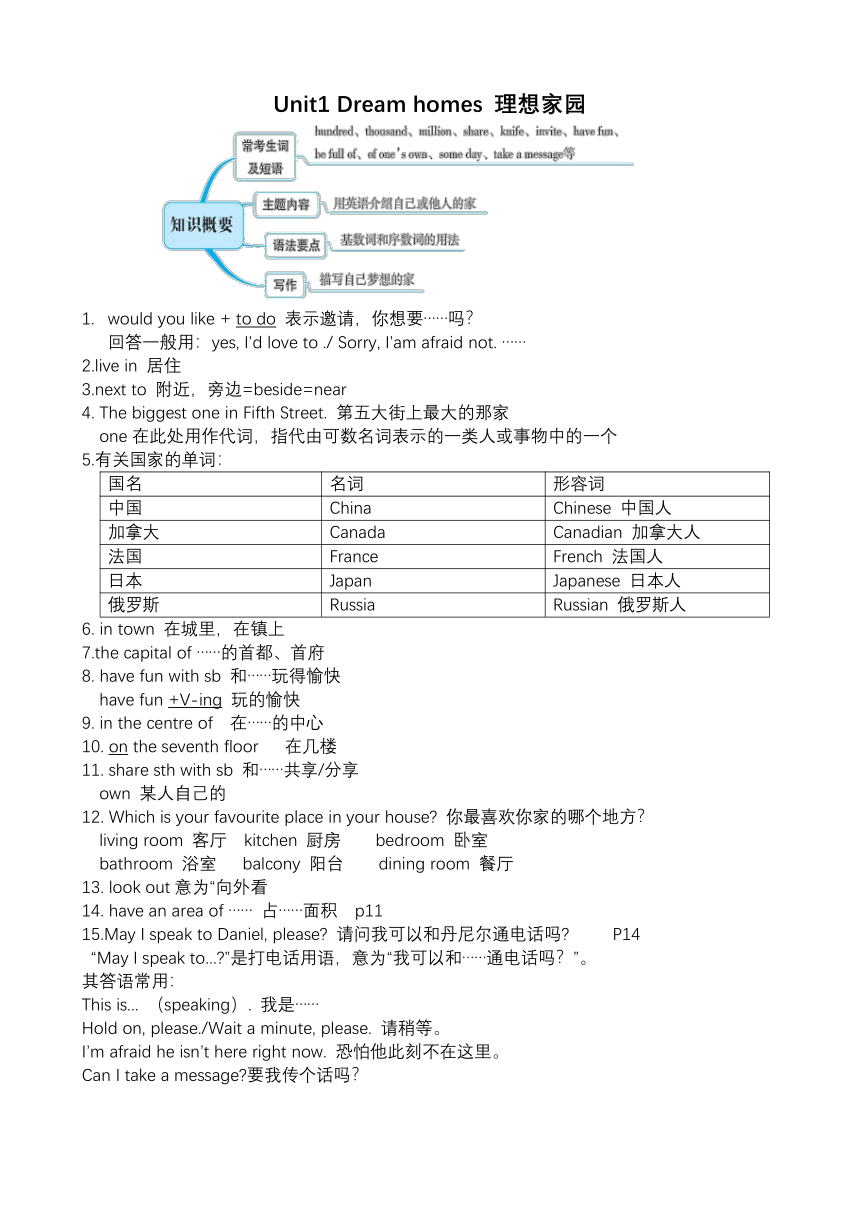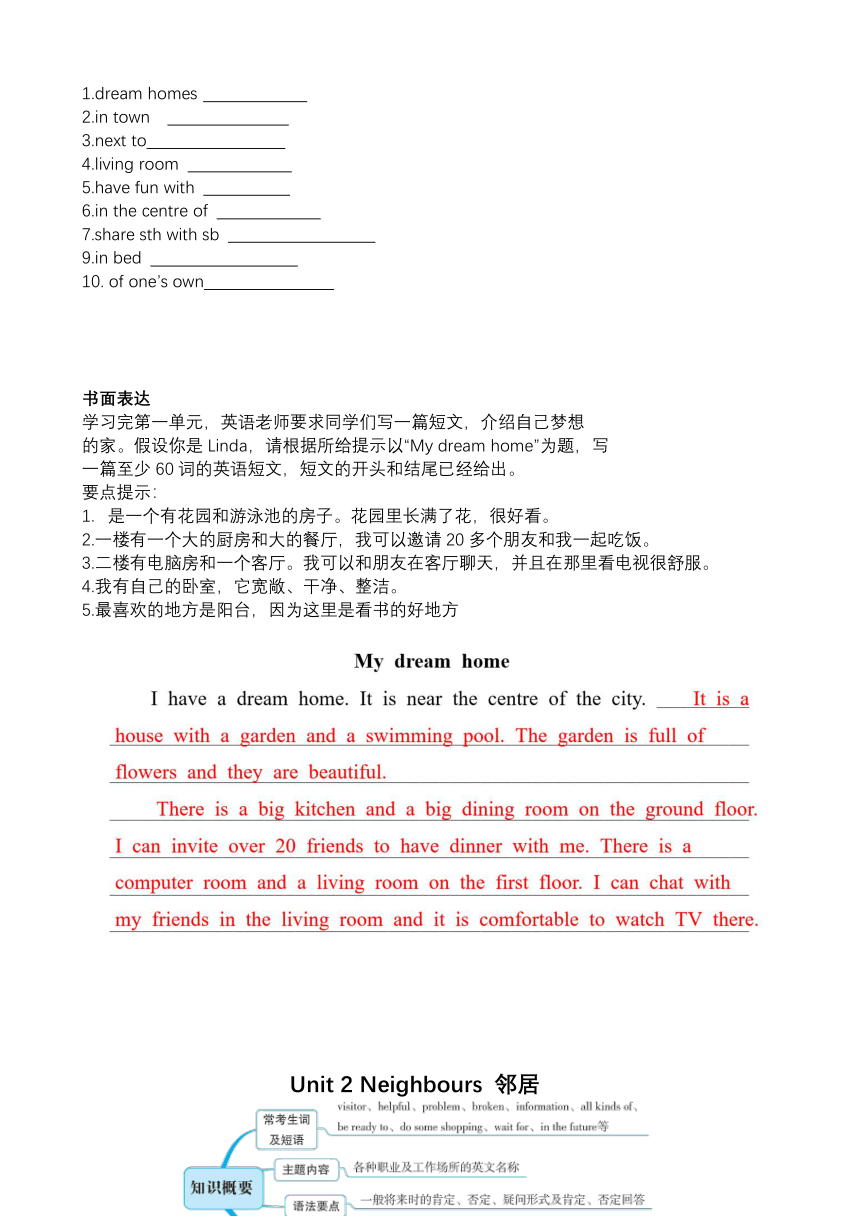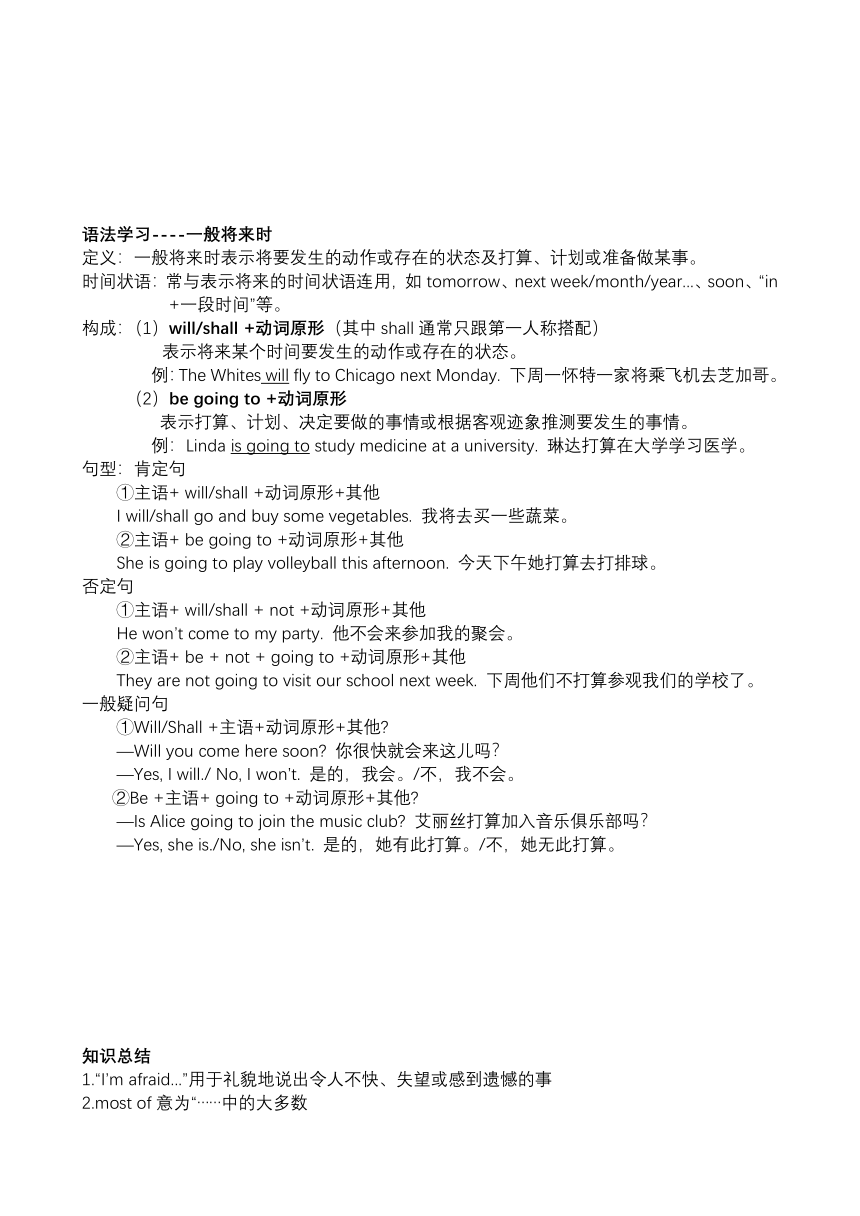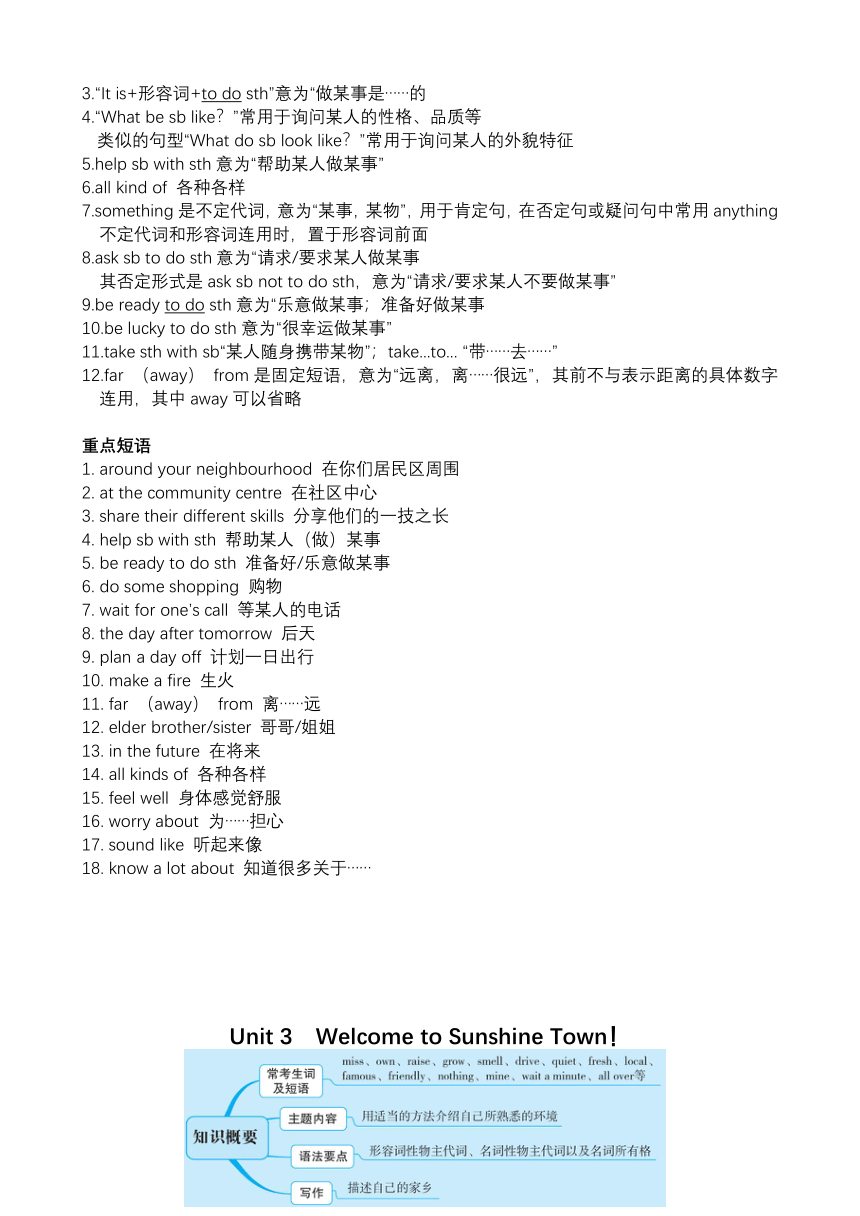Unit1-8知识点总结2023-2024学年牛津译林版英语七年级下册
文档属性
| 名称 | Unit1-8知识点总结2023-2024学年牛津译林版英语七年级下册 |  | |
| 格式 | docx | ||
| 文件大小 | 1.4MB | ||
| 资源类型 | 教案 | ||
| 版本资源 | 牛津译林版 | ||
| 科目 | 英语 | ||
| 更新时间 | 2024-06-28 18:52:17 | ||
图片预览





文档简介
Unit1 Dream homes 理想家园
would you like + to do 表示邀请,你想要……吗?
回答一般用:yes, I’d love to ./ Sorry, I’am afraid not. ……
2.live in 居住
3.next to 附近,旁边=beside=near
4. The biggest one in Fifth Street. 第五大街上最大的那家
one在此处用作代词,指代由可数名词表示的一类人或事物中的一个
5.有关国家的单词:
国名 名词 形容词
中国 China Chinese 中国人
加拿大 Canada Canadian 加拿大人
法国 France French 法国人
日本 Japan Japanese 日本人
俄罗斯 Russia Russian 俄罗斯人
6. in town 在城里,在镇上
7.the capital of ……的首都、首府
8. have fun with sb 和……玩得愉快
have fun +V-ing 玩的愉快
9. in the centre of 在……的中心
10. on the seventh floor 在几楼
11. share sth with sb 和……共享/分享
own 某人自己的
12. Which is your favourite place in your house 你最喜欢你家的哪个地方?
living room 客厅 kitchen 厨房 bedroom 卧室
bathroom 浴室 balcony 阳台 dining room 餐厅
13. look out意为“向外看
14. have an area of …… 占……面积 p11
15.May I speak to Daniel, please 请问我可以和丹尼尔通电话吗 P14
“May I speak to... ”是打电话用语,意为“我可以和……通电话吗?”。
其答语常用:
This is... (speaking). 我是……
Hold on, please./Wait a minute, please. 请稍等。
I’m afraid he isn’t here right now. 恐怕他此刻不在这里。
Can I take a message 要我传个话吗?
Grammar
1.基数词
定义:基数词常用来表示数量的多少,在句中相当于名词或形容词,可作主语、定语或表语。
(1) 基数词的构成
①0~12的基数词有各自独立的表达,要分别熟记,如zero、one、
two、three、four、five、six、seven、eight、nine、ten、eleven、twelve。
②13~19的基数词均以-teen结尾,如thirteen、fourteen、fifteen、
sixteen、seventeen、eighteen、nineteen。
③20~90的整十的基数词均以-ty结尾,如twenty、thirty、forty、
fifty、sixty、seventy、eighty、ninety。
④21~99等表示“几十几”的基数词,由十位数和个位数之间加连字符“-”构成。如forty-three、fifty-four等。
⑤100~999的基数词是在百位数hundred之后加and,再加十位数和个位数。
2.序数词
序数词表示人或事物的先后顺序,常用来谈论日期、楼层、位置等。
(1)序数词的构成
①一般由相应的基数词后加-th构成。注意下列特殊变化:
one→first; two→second; three→third; five→fifth; eight→eighth; nine→ninth; twelve→twelfth
②以-ty结尾表示整十的基数词变为序数词时,将y变为ie,再加-th。例如:
twenty→twentieth thirty→thirtieth
即时训练
( ) 1.—Would you like to go to Shanghai Disneyland with me in July
—______.
A.Yes, I’d like to B.It doesn’t matter C.Have a good time
( )2. —Does Linda come from ________ China
—No, she is from ________ USA.
A.the; \ B.\; the C.\; \
( )3.The Eiffel Tower in ________ is famous around the world.
A.Canada B.France C.Japan
( )4.—Where is the Bank of China
—It’s ________ the hospital.
A.next B.next to C.near to
( )5.There is ________ nice living room in my flat. I like to watch TV there.
A.a B.an C.the
短语归纳
1.dream homes
2.in town
3.next to
4.living room
5.have fun with
6.in the centre of
7.share sth with sb
9.in bed
10. of one’s own
书面表达
学习完第一单元,英语老师要求同学们写一篇短文,介绍自己梦想
的家。假设你是Linda,请根据所给提示以“My dream home”为题,写
一篇至少60词的英语短文,短文的开头和结尾已经给出。
要点提示:
是一个有花园和游泳池的房子。花园里长满了花,很好看。
2.一楼有一个大的厨房和大的餐厅,我可以邀请20多个朋友和我一起吃饭。
3.二楼有电脑房和一个客厅。我可以和朋友在客厅聊天,并且在那里看电视很舒服。
4.我有自己的卧室,它宽敞、干净、整洁。
5.最喜欢的地方是阳台,因为这里是看书的好地方
Unit 2 Neighbours 邻居
语法学习----一般将来时
定义:一般将来时表示将要发生的动作或存在的状态及打算、计划或准备做某事。
时间状语:常与表示将来的时间状语连用,如tomorrow、next week/month/year...、soon、“in +一段时间”等。
构成:(1)will/shall +动词原形(其中shall通常只跟第一人称搭配)
表示将来某个时间要发生的动作或存在的状态。
例:The Whites will fly to Chicago next Monday. 下周一怀特一家将乘飞机去芝加哥。
(2)be going to +动词原形
表示打算、计划、决定要做的事情或根据客观迹象推测要发生的事情。
例:Linda is going to study medicine at a university. 琳达打算在大学学习医学。
句型:肯定句
①主语+ will/shall +动词原形+其他
I will/shall go and buy some vegetables. 我将去买一些蔬菜。
②主语+ be going to +动词原形+其他
She is going to play volleyball this afternoon. 今天下午她打算去打排球。
否定句
①主语+ will/shall + not +动词原形+其他
He won’t come to my party. 他不会来参加我的聚会。
②主语+ be + not + going to +动词原形+其他
They are not going to visit our school next week. 下周他们不打算参观我们的学校了。
一般疑问句
①Will/Shall +主语+动词原形+其他
—Will you come here soon 你很快就会来这儿吗?
—Yes, I will./ No, I won’t. 是的,我会。/不,我不会。
②Be +主语+ going to +动词原形+其他
—Is Alice going to join the music club 艾丽丝打算加入音乐俱乐部吗?
—Yes, she is./No, she isn’t. 是的,她有此打算。/不,她无此打算。
知识总结
1.“I’m afraid...”用于礼貌地说出令人不快、失望或感到遗憾的事
2.most of意为“……中的大多数
3.“It is+形容词+to do sth”意为“做某事是……的
4.“What be sb like?”常用于询问某人的性格、品质等
类似的句型“What do sb look like?”常用于询问某人的外貌特征
5.help sb with sth意为“帮助某人做某事”
6.all kind of 各种各样
7.something是不定代词,意为“某事,某物”,用于肯定句,在否定句或疑问句中常用anything
不定代词和形容词连用时,置于形容词前面
8.ask sb to do sth意为“请求/要求某人做某事
其否定形式是ask sb not to do sth,意为“请求/要求某人不要做某事”
9.be ready to do sth意为“乐意做某事;准备好做某事
10.be lucky to do sth意为“很幸运做某事”
11.take sth with sb“某人随身携带某物”;take...to... “带……去……”
12.far (away) from是固定短语,意为“远离,离……很远”,其前不与表示距离的具体数字连用,其中away可以省略
重点短语
1. around your neighbourhood 在你们居民区周围
2. at the community centre 在社区中心
3. share their different skills 分享他们的一技之长
4. help sb with sth 帮助某人(做)某事
5. be ready to do sth 准备好/乐意做某事
6. do some shopping 购物
7. wait for one’s call 等某人的电话
8. the day after tomorrow 后天
9. plan a day off 计划一日出行
10. make a fire 生火
11. far (away) from 离……远
12. elder brother/sister 哥哥/姐姐
13. in the future 在将来
14. all kinds of 各种各样
15. feel well 身体感觉舒服
16. worry about 为……担心
17. sound like 听起来像
18. know a lot about 知道很多关于……
Unit 3 Welcome to Sunshine Town!
知识总结:
1.an old friend of mine 意为“我的一个老朋友”
2.nothing 不定代词,表示否定含义,什么都没有
3.let’s+动词原形 表示 “让我们做某事”
4.wait a minute 稍等
5.maybe 是副词,表示猜测,意为“可能,大概,或许“
6.order 是及物动词,意为“点,要(酒菜);订购”
7.take sb to do sth 带某人去某地
8.would like to do sth 想做某事
9.invite sb to do sth 邀请某人做某事
10.good idea! 好主意
11.welcome to +地点 欢迎来到……
12.There be +sth+ to do...”意为“有某事可做/需要做”,是固定句型
13.stay in …… 待在
14.“It takes (sb)+一段时间+ to do sth”表示“(某人)花一段时间做某事”
1.famous 是形容词,意为“出名的,著名的
be famous for 后接出名的原因,意为“因……而著名/出名”
16.Western 是形容词,意为“西方的”
17.“Why not +动词原形+其他?”意为“为什么不做某事呢?”
18.enjoy +V-ing 喜欢、享受做某事
19.miss意为“错过,失去”
20.look forward to +V-ing 意为“期盼,期待”
21.works of art 艺术品
22.many more ……还有很多
23.row a boat 意为“划船”
24.how far 是疑问词组,常对距离进行提问
25.smell 用作及物动词,意为“闻,嗅到
26.hear sb do sth 意为“听见某人做某事
hear sb doing sth 意为“听见某人正在做某事”,强调动作正在进行
语法学习----名词所有格
定义:名词所有格主要用于表示人或物的所有关系。其构成规则如下:
(1) 单数名词和不以-s 结尾的复数名词在词尾加“’s”构成所有格。例如:
the girl’s father 女孩的父亲
Children’s Day 儿童节
(2) 以-s 或-es 结尾的复数名词,只需要在 s 后面加“’”。例如:
the teachers’ offices 教师们的办公室
(3) 如果表示两者各自拥有的东西,需要在两个名词的词尾都加“’s”;如果表示两者共同拥有一个东西,则只在位置靠后的名词词尾加“’s”。例如:
Tom’s and John’s bedrooms 汤姆和约翰(各自)的卧室
Tom and John’s bedroom 汤姆和约翰(共有)的卧室
(4) 名词所有格也用于表示时间、距离、集体、城市、国家、团体、机构等非生命意义的名词。
语法学习----物主代词
定义:物主代词是表示所有关系的代词,分为形容词性物主代词和名词性物主代词
1. Mr Jackson is a popular writer, and we all like reading ______ books.
A. his B. her C. their
2. Mum, I want to buy two ______. One is for you and the other is for Dad.
A. keys ring B. key ring C. key ring
3. —Who is the man over there
—Oh, he is Mr Brown, ______ uncle.
A. Jim’s and Sam B. Jim and Sam’s C. Jim’s and Sam’s
4. Upstairs are ______ bedrooms. They are tidy and nice.
A. Linda’s and Sandy B. Linda and Sandy’s C. Linda’s and Sandy’s
5. —Look at the sports shoes under the chair. Are they yours, Jenny
—No. Mine ______ red and blue.
A. are B. am C. is
6. —Hey! How do you like the city of Chengdu
—It’s beautiful! And this is ______ time to visit Chengdu.
A. my second B. mine second C. my the second
Unit 4 Finding your way
语法学习----冠词
定义:冠词是一种放在名词前帮助说明名词的虚词,它不能离开名词而单独存在。
种类:冠词有两种,一种是不定冠词 a 和 an,一种是定冠词 the。
用法:不定冠词 a 和 an 用在单数可数名词前。
其中 a 用于发音以辅音音素开头的单数可数名词前,如 a car、a pen 等;an 用在发音以元音音素开头的单数可数名词前,如 an apple、an hour 等
P120
语法学习----方位介词
方位介词常用来说明人或物所在的位置
in、 on、 under、
between、 at、
behind、 in front of、
inside、 outside、
above、 below、
beside(=next to)
知识总结:
1.follow me 跟着我
2.between 在……之间
3.go down 往下走
4.come with sb 跟着某人
5.have to 不得不
6.go up 向上走
7.is north of 在……的北面 west 西 south 南 east 东
8.far away from 离得远
9.a trip to +地点 去……旅行
10.in front of 在……的前面
11.go straight on 意为“一直向前走 12.all day long 意为“整天地
13.walk along 意为“沿着……走”,相当于 go along
14.remember +that 从句 记得……
remember to do sth 意为“记得要做某事”(事情还没有做);
remember doing sth 意为“记得做过某事”(事情已经做了)。
15.make sb do sth 是固定结构,意为“使/让某人做某事”。
16.turn left 向左转 turn right 向右转 17.quite 十分
18.cross 作动词,意为“穿过,横过”,主要表示在物体表面上横穿。
常用短语为: cross the street/road/river/bridge
Unit 5 Amazing things
知识总结:
look at 看
come on 快点;加油
fun facts 趣事
“with +名词+形容词/介词短语” 结构在句中作伴随性状语
Fish sleep with their eyes open. 鱼儿睁着眼睛睡觉
birth出生,诞生” 常用短语有:at birth“在出生时”;give birth (to)“生孩子”
stop doing sth “停止做某事”,指停止正在做的事情
stop to do sth“停下来去做某事”,指停止正在做的事情,去做另一件事。
英语中谈论天文学中的星球时,星球名称的首字母应大写。平时提及“太阳”“地球”“月亮”时,则无需大写
in the back of 在……后面
time是可数名词,意为“倍”,复数形式为times
as usual“照例;像往常一样”
sit down 坐下
turn around 转向四周
Is anybody there 那儿有人吗?
Nobody replied. 没有人回答 reply to“对……作出回答/答复”
on one’s/the way意为“在……路上”
What happened 发生了什么事?sth happen(s) to sb/sth (意为“某人/某物发生某事”)。
search sth“搜查某物” search(+for...)查找
say to oneself“自言自语,心里想
pick up 捡起
surprised是形容词,通常用来形容人的感受,意为“感到惊讶的
be surprised at sth意为“对某事/物感到惊讶
be surprised to do sth意为“做某事感到惊讶
语法学习:一般过去时1
定义:一般过去时表示过去某个时间发生的动作、过去某个时间段存在的状态、过去习惯性、经常性的动作。
结构:(1) 主语+be(was, were)+其他。例如: They were students. 他们过去是学生。
(2) 主语+实意动词(过去式)+其他。I lived in the town twenty years ago.
时间状语:yesterday、last night/week/ month/year、“一段时间+ago”、in 2003、just now等
动词过去式的变化规则:
(1) 规则变化:
①一般情况下,在动词原形后直接加-ed。例如:walk-walked。
②以不发音的字母e结尾的动词在其后加-d。例如:live-lived。
③以“辅音字母加y结尾”的动词,把y变成i再加-ed。例如:
carry-carried。
④以重读闭音节结尾且末尾只有一个辅音字母的动词,双写该辅音字母,再加-ed。例如:stop-stopped。
(2) 不规则变化:不规则动词的过去式需特殊记忆 课本p106-107
Unit 6 Outdoor fun
知识总结:
hurry up 赶快
carry sth for sb 拿某物给某人
too +形容词 太……
complain about/of sth“抱怨某事 complain to sb(about/of sth)“向某人抱怨(某事)”
too much 太多
by “在……旁边,靠近……”,by a river 在河边
look up“向上看
pass by“通过,经过
take...out of...“把……从……中拿出来
run after 追逐
across 穿过
jump down 跳入
for a long time 很长一段时间
try to do sth“尽力做某事
through是介词,意为“穿过,通过”,指穿过隧道、窗户、门、森林等
语法学习---一般过去时2
1.含有be动词的一般过去时的否定句、疑问句及其简略回答
含有be动词的一般过去时的基本结构为:主语+was/were+其他。(肯定句)
Unit 7 Abilities
知识总结:
Believe it or not. 信不信由你。
Look out 小心;当心!
clean up 打扫
in poor area 在贫困区
send sb sth=send sth to sb,把某物发送/邮寄给某人
be able to do sth能做某事
pay for 支付
raise money for“为……筹钱”
形容词+enough +to do 足够……去做某事
Save…… from 从……拯救
hear sb doing sth 听到某人正在……
go in 走进
79-year-old是复合形容词
rush into 冲进
help sb out “帮助某人摆脱(困境)”
put out“扑灭;熄灭”
be careful with 对……小心
语法学习---情态动词can、could与may
情态动词表示说话人对某一动作的观点,如需要、可能、意愿、怀疑等。
can表示主语现在具备的能力,常与表示现在的时间状语连用;
could则表示主语过去所具备的能力,常和表示过去的时间状语连用
may可表示请求或征求许可,比较正式
what和how引导的感叹句
What +a/an+形容词+可数名词单数(+主语+谓语+其他)
What a brave young man (he is)! (他是一位)多么勇敢的年轻人啊!
What +形容词+可数名词复数或不可数名词(+主语+谓语+其他)!
What beautiful flowers (they are)! (它们是)多么美丽的花啊!
How +形容词(+主语+谓语+其他)!(谓语用连系动词)例如:
How happy (the children are)!(这些孩子)多快乐啊!
How +副词(+主语+谓语+其他)!(谓语用行为动词)例如:
How fast(he ran just now)! (他刚才跑得)多快啊!
Unit 8 Pets
知识总结:
bring sb sth=bring sth to sb,“把某物带(来)给某人”
something to eat“吃的东西”
That’s it. 就是这样
feed“喂,喂养”,其过去式是fed。(1) feed on“以……为食”
(2) feed sth to sb/sth= feed sb/sth (on) sth“给某人/某物喂……”
5. teach sb sth“教某人某事”
teach sb to do sth“教某人做某事”
run after“追逐,追赶”
look after“照顾,照料
till“到……时,直到……为止
in trouble“处于困境中
语法学习——形容词 课本p123
would you like + to do 表示邀请,你想要……吗?
回答一般用:yes, I’d love to ./ Sorry, I’am afraid not. ……
2.live in 居住
3.next to 附近,旁边=beside=near
4. The biggest one in Fifth Street. 第五大街上最大的那家
one在此处用作代词,指代由可数名词表示的一类人或事物中的一个
5.有关国家的单词:
国名 名词 形容词
中国 China Chinese 中国人
加拿大 Canada Canadian 加拿大人
法国 France French 法国人
日本 Japan Japanese 日本人
俄罗斯 Russia Russian 俄罗斯人
6. in town 在城里,在镇上
7.the capital of ……的首都、首府
8. have fun with sb 和……玩得愉快
have fun +V-ing 玩的愉快
9. in the centre of 在……的中心
10. on the seventh floor 在几楼
11. share sth with sb 和……共享/分享
own 某人自己的
12. Which is your favourite place in your house 你最喜欢你家的哪个地方?
living room 客厅 kitchen 厨房 bedroom 卧室
bathroom 浴室 balcony 阳台 dining room 餐厅
13. look out意为“向外看
14. have an area of …… 占……面积 p11
15.May I speak to Daniel, please 请问我可以和丹尼尔通电话吗 P14
“May I speak to... ”是打电话用语,意为“我可以和……通电话吗?”。
其答语常用:
This is... (speaking). 我是……
Hold on, please./Wait a minute, please. 请稍等。
I’m afraid he isn’t here right now. 恐怕他此刻不在这里。
Can I take a message 要我传个话吗?
Grammar
1.基数词
定义:基数词常用来表示数量的多少,在句中相当于名词或形容词,可作主语、定语或表语。
(1) 基数词的构成
①0~12的基数词有各自独立的表达,要分别熟记,如zero、one、
two、three、four、five、six、seven、eight、nine、ten、eleven、twelve。
②13~19的基数词均以-teen结尾,如thirteen、fourteen、fifteen、
sixteen、seventeen、eighteen、nineteen。
③20~90的整十的基数词均以-ty结尾,如twenty、thirty、forty、
fifty、sixty、seventy、eighty、ninety。
④21~99等表示“几十几”的基数词,由十位数和个位数之间加连字符“-”构成。如forty-three、fifty-four等。
⑤100~999的基数词是在百位数hundred之后加and,再加十位数和个位数。
2.序数词
序数词表示人或事物的先后顺序,常用来谈论日期、楼层、位置等。
(1)序数词的构成
①一般由相应的基数词后加-th构成。注意下列特殊变化:
one→first; two→second; three→third; five→fifth; eight→eighth; nine→ninth; twelve→twelfth
②以-ty结尾表示整十的基数词变为序数词时,将y变为ie,再加-th。例如:
twenty→twentieth thirty→thirtieth
即时训练
( ) 1.—Would you like to go to Shanghai Disneyland with me in July
—______.
A.Yes, I’d like to B.It doesn’t matter C.Have a good time
( )2. —Does Linda come from ________ China
—No, she is from ________ USA.
A.the; \ B.\; the C.\; \
( )3.The Eiffel Tower in ________ is famous around the world.
A.Canada B.France C.Japan
( )4.—Where is the Bank of China
—It’s ________ the hospital.
A.next B.next to C.near to
( )5.There is ________ nice living room in my flat. I like to watch TV there.
A.a B.an C.the
短语归纳
1.dream homes
2.in town
3.next to
4.living room
5.have fun with
6.in the centre of
7.share sth with sb
9.in bed
10. of one’s own
书面表达
学习完第一单元,英语老师要求同学们写一篇短文,介绍自己梦想
的家。假设你是Linda,请根据所给提示以“My dream home”为题,写
一篇至少60词的英语短文,短文的开头和结尾已经给出。
要点提示:
是一个有花园和游泳池的房子。花园里长满了花,很好看。
2.一楼有一个大的厨房和大的餐厅,我可以邀请20多个朋友和我一起吃饭。
3.二楼有电脑房和一个客厅。我可以和朋友在客厅聊天,并且在那里看电视很舒服。
4.我有自己的卧室,它宽敞、干净、整洁。
5.最喜欢的地方是阳台,因为这里是看书的好地方
Unit 2 Neighbours 邻居
语法学习----一般将来时
定义:一般将来时表示将要发生的动作或存在的状态及打算、计划或准备做某事。
时间状语:常与表示将来的时间状语连用,如tomorrow、next week/month/year...、soon、“in +一段时间”等。
构成:(1)will/shall +动词原形(其中shall通常只跟第一人称搭配)
表示将来某个时间要发生的动作或存在的状态。
例:The Whites will fly to Chicago next Monday. 下周一怀特一家将乘飞机去芝加哥。
(2)be going to +动词原形
表示打算、计划、决定要做的事情或根据客观迹象推测要发生的事情。
例:Linda is going to study medicine at a university. 琳达打算在大学学习医学。
句型:肯定句
①主语+ will/shall +动词原形+其他
I will/shall go and buy some vegetables. 我将去买一些蔬菜。
②主语+ be going to +动词原形+其他
She is going to play volleyball this afternoon. 今天下午她打算去打排球。
否定句
①主语+ will/shall + not +动词原形+其他
He won’t come to my party. 他不会来参加我的聚会。
②主语+ be + not + going to +动词原形+其他
They are not going to visit our school next week. 下周他们不打算参观我们的学校了。
一般疑问句
①Will/Shall +主语+动词原形+其他
—Will you come here soon 你很快就会来这儿吗?
—Yes, I will./ No, I won’t. 是的,我会。/不,我不会。
②Be +主语+ going to +动词原形+其他
—Is Alice going to join the music club 艾丽丝打算加入音乐俱乐部吗?
—Yes, she is./No, she isn’t. 是的,她有此打算。/不,她无此打算。
知识总结
1.“I’m afraid...”用于礼貌地说出令人不快、失望或感到遗憾的事
2.most of意为“……中的大多数
3.“It is+形容词+to do sth”意为“做某事是……的
4.“What be sb like?”常用于询问某人的性格、品质等
类似的句型“What do sb look like?”常用于询问某人的外貌特征
5.help sb with sth意为“帮助某人做某事”
6.all kind of 各种各样
7.something是不定代词,意为“某事,某物”,用于肯定句,在否定句或疑问句中常用anything
不定代词和形容词连用时,置于形容词前面
8.ask sb to do sth意为“请求/要求某人做某事
其否定形式是ask sb not to do sth,意为“请求/要求某人不要做某事”
9.be ready to do sth意为“乐意做某事;准备好做某事
10.be lucky to do sth意为“很幸运做某事”
11.take sth with sb“某人随身携带某物”;take...to... “带……去……”
12.far (away) from是固定短语,意为“远离,离……很远”,其前不与表示距离的具体数字连用,其中away可以省略
重点短语
1. around your neighbourhood 在你们居民区周围
2. at the community centre 在社区中心
3. share their different skills 分享他们的一技之长
4. help sb with sth 帮助某人(做)某事
5. be ready to do sth 准备好/乐意做某事
6. do some shopping 购物
7. wait for one’s call 等某人的电话
8. the day after tomorrow 后天
9. plan a day off 计划一日出行
10. make a fire 生火
11. far (away) from 离……远
12. elder brother/sister 哥哥/姐姐
13. in the future 在将来
14. all kinds of 各种各样
15. feel well 身体感觉舒服
16. worry about 为……担心
17. sound like 听起来像
18. know a lot about 知道很多关于……
Unit 3 Welcome to Sunshine Town!
知识总结:
1.an old friend of mine 意为“我的一个老朋友”
2.nothing 不定代词,表示否定含义,什么都没有
3.let’s+动词原形 表示 “让我们做某事”
4.wait a minute 稍等
5.maybe 是副词,表示猜测,意为“可能,大概,或许“
6.order 是及物动词,意为“点,要(酒菜);订购”
7.take sb to do sth 带某人去某地
8.would like to do sth 想做某事
9.invite sb to do sth 邀请某人做某事
10.good idea! 好主意
11.welcome to +地点 欢迎来到……
12.There be +sth+ to do...”意为“有某事可做/需要做”,是固定句型
13.stay in …… 待在
14.“It takes (sb)+一段时间+ to do sth”表示“(某人)花一段时间做某事”
1.famous 是形容词,意为“出名的,著名的
be famous for 后接出名的原因,意为“因……而著名/出名”
16.Western 是形容词,意为“西方的”
17.“Why not +动词原形+其他?”意为“为什么不做某事呢?”
18.enjoy +V-ing 喜欢、享受做某事
19.miss意为“错过,失去”
20.look forward to +V-ing 意为“期盼,期待”
21.works of art 艺术品
22.many more ……还有很多
23.row a boat 意为“划船”
24.how far 是疑问词组,常对距离进行提问
25.smell 用作及物动词,意为“闻,嗅到
26.hear sb do sth 意为“听见某人做某事
hear sb doing sth 意为“听见某人正在做某事”,强调动作正在进行
语法学习----名词所有格
定义:名词所有格主要用于表示人或物的所有关系。其构成规则如下:
(1) 单数名词和不以-s 结尾的复数名词在词尾加“’s”构成所有格。例如:
the girl’s father 女孩的父亲
Children’s Day 儿童节
(2) 以-s 或-es 结尾的复数名词,只需要在 s 后面加“’”。例如:
the teachers’ offices 教师们的办公室
(3) 如果表示两者各自拥有的东西,需要在两个名词的词尾都加“’s”;如果表示两者共同拥有一个东西,则只在位置靠后的名词词尾加“’s”。例如:
Tom’s and John’s bedrooms 汤姆和约翰(各自)的卧室
Tom and John’s bedroom 汤姆和约翰(共有)的卧室
(4) 名词所有格也用于表示时间、距离、集体、城市、国家、团体、机构等非生命意义的名词。
语法学习----物主代词
定义:物主代词是表示所有关系的代词,分为形容词性物主代词和名词性物主代词
1. Mr Jackson is a popular writer, and we all like reading ______ books.
A. his B. her C. their
2. Mum, I want to buy two ______. One is for you and the other is for Dad.
A. keys ring B. key ring C. key ring
3. —Who is the man over there
—Oh, he is Mr Brown, ______ uncle.
A. Jim’s and Sam B. Jim and Sam’s C. Jim’s and Sam’s
4. Upstairs are ______ bedrooms. They are tidy and nice.
A. Linda’s and Sandy B. Linda and Sandy’s C. Linda’s and Sandy’s
5. —Look at the sports shoes under the chair. Are they yours, Jenny
—No. Mine ______ red and blue.
A. are B. am C. is
6. —Hey! How do you like the city of Chengdu
—It’s beautiful! And this is ______ time to visit Chengdu.
A. my second B. mine second C. my the second
Unit 4 Finding your way
语法学习----冠词
定义:冠词是一种放在名词前帮助说明名词的虚词,它不能离开名词而单独存在。
种类:冠词有两种,一种是不定冠词 a 和 an,一种是定冠词 the。
用法:不定冠词 a 和 an 用在单数可数名词前。
其中 a 用于发音以辅音音素开头的单数可数名词前,如 a car、a pen 等;an 用在发音以元音音素开头的单数可数名词前,如 an apple、an hour 等
P120
语法学习----方位介词
方位介词常用来说明人或物所在的位置
in、 on、 under、
between、 at、
behind、 in front of、
inside、 outside、
above、 below、
beside(=next to)
知识总结:
1.follow me 跟着我
2.between 在……之间
3.go down 往下走
4.come with sb 跟着某人
5.have to 不得不
6.go up 向上走
7.is north of 在……的北面 west 西 south 南 east 东
8.far away from 离得远
9.a trip to +地点 去……旅行
10.in front of 在……的前面
11.go straight on 意为“一直向前走 12.all day long 意为“整天地
13.walk along 意为“沿着……走”,相当于 go along
14.remember +that 从句 记得……
remember to do sth 意为“记得要做某事”(事情还没有做);
remember doing sth 意为“记得做过某事”(事情已经做了)。
15.make sb do sth 是固定结构,意为“使/让某人做某事”。
16.turn left 向左转 turn right 向右转 17.quite 十分
18.cross 作动词,意为“穿过,横过”,主要表示在物体表面上横穿。
常用短语为: cross the street/road/river/bridge
Unit 5 Amazing things
知识总结:
look at 看
come on 快点;加油
fun facts 趣事
“with +名词+形容词/介词短语” 结构在句中作伴随性状语
Fish sleep with their eyes open. 鱼儿睁着眼睛睡觉
birth出生,诞生” 常用短语有:at birth“在出生时”;give birth (to)“生孩子”
stop doing sth “停止做某事”,指停止正在做的事情
stop to do sth“停下来去做某事”,指停止正在做的事情,去做另一件事。
英语中谈论天文学中的星球时,星球名称的首字母应大写。平时提及“太阳”“地球”“月亮”时,则无需大写
in the back of 在……后面
time是可数名词,意为“倍”,复数形式为times
as usual“照例;像往常一样”
sit down 坐下
turn around 转向四周
Is anybody there 那儿有人吗?
Nobody replied. 没有人回答 reply to“对……作出回答/答复”
on one’s/the way意为“在……路上”
What happened 发生了什么事?sth happen(s) to sb/sth (意为“某人/某物发生某事”)。
search sth“搜查某物” search(+for...)查找
say to oneself“自言自语,心里想
pick up 捡起
surprised是形容词,通常用来形容人的感受,意为“感到惊讶的
be surprised at sth意为“对某事/物感到惊讶
be surprised to do sth意为“做某事感到惊讶
语法学习:一般过去时1
定义:一般过去时表示过去某个时间发生的动作、过去某个时间段存在的状态、过去习惯性、经常性的动作。
结构:(1) 主语+be(was, were)+其他。例如: They were students. 他们过去是学生。
(2) 主语+实意动词(过去式)+其他。I lived in the town twenty years ago.
时间状语:yesterday、last night/week/ month/year、“一段时间+ago”、in 2003、just now等
动词过去式的变化规则:
(1) 规则变化:
①一般情况下,在动词原形后直接加-ed。例如:walk-walked。
②以不发音的字母e结尾的动词在其后加-d。例如:live-lived。
③以“辅音字母加y结尾”的动词,把y变成i再加-ed。例如:
carry-carried。
④以重读闭音节结尾且末尾只有一个辅音字母的动词,双写该辅音字母,再加-ed。例如:stop-stopped。
(2) 不规则变化:不规则动词的过去式需特殊记忆 课本p106-107
Unit 6 Outdoor fun
知识总结:
hurry up 赶快
carry sth for sb 拿某物给某人
too +形容词 太……
complain about/of sth“抱怨某事 complain to sb(about/of sth)“向某人抱怨(某事)”
too much 太多
by “在……旁边,靠近……”,by a river 在河边
look up“向上看
pass by“通过,经过
take...out of...“把……从……中拿出来
run after 追逐
across 穿过
jump down 跳入
for a long time 很长一段时间
try to do sth“尽力做某事
through是介词,意为“穿过,通过”,指穿过隧道、窗户、门、森林等
语法学习---一般过去时2
1.含有be动词的一般过去时的否定句、疑问句及其简略回答
含有be动词的一般过去时的基本结构为:主语+was/were+其他。(肯定句)
Unit 7 Abilities
知识总结:
Believe it or not. 信不信由你。
Look out 小心;当心!
clean up 打扫
in poor area 在贫困区
send sb sth=send sth to sb,把某物发送/邮寄给某人
be able to do sth能做某事
pay for 支付
raise money for“为……筹钱”
形容词+enough +to do 足够……去做某事
Save…… from 从……拯救
hear sb doing sth 听到某人正在……
go in 走进
79-year-old是复合形容词
rush into 冲进
help sb out “帮助某人摆脱(困境)”
put out“扑灭;熄灭”
be careful with 对……小心
语法学习---情态动词can、could与may
情态动词表示说话人对某一动作的观点,如需要、可能、意愿、怀疑等。
can表示主语现在具备的能力,常与表示现在的时间状语连用;
could则表示主语过去所具备的能力,常和表示过去的时间状语连用
may可表示请求或征求许可,比较正式
what和how引导的感叹句
What +a/an+形容词+可数名词单数(+主语+谓语+其他)
What a brave young man (he is)! (他是一位)多么勇敢的年轻人啊!
What +形容词+可数名词复数或不可数名词(+主语+谓语+其他)!
What beautiful flowers (they are)! (它们是)多么美丽的花啊!
How +形容词(+主语+谓语+其他)!(谓语用连系动词)例如:
How happy (the children are)!(这些孩子)多快乐啊!
How +副词(+主语+谓语+其他)!(谓语用行为动词)例如:
How fast(he ran just now)! (他刚才跑得)多快啊!
Unit 8 Pets
知识总结:
bring sb sth=bring sth to sb,“把某物带(来)给某人”
something to eat“吃的东西”
That’s it. 就是这样
feed“喂,喂养”,其过去式是fed。(1) feed on“以……为食”
(2) feed sth to sb/sth= feed sb/sth (on) sth“给某人/某物喂……”
5. teach sb sth“教某人某事”
teach sb to do sth“教某人做某事”
run after“追逐,追赶”
look after“照顾,照料
till“到……时,直到……为止
in trouble“处于困境中
语法学习——形容词 课本p123
同课章节目录
